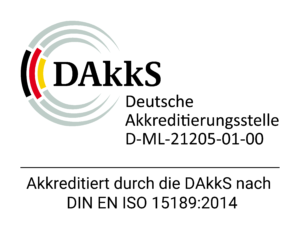Determination of the fetal RhD status from maternal blood
In Europe around 17% of all pregnant women are RhD-negative. Since the beginning of the 1990s, these women have been receiving RhD prophylaxis in the 28th to 30th week of pregnancy in addition to the targeted postpartum administration. This prenatal Rh prophylaxis, which is usually carried out independently of the RhD status of the fetus, reduces the risk of Rh sensitization from 1 – 2% to 0.2 – 0.3% 1.
With the Rhesus NIPT it is now possible to determine the fetal RhD status prenatally non-invasively from maternal blood2. Unnecessary anti-D immunoglobulin treatment, which carries at least a theoretical risk of infection, can be avoided.
Test reliability
The quantitative PCR test used for Rhesus NIPT examines the three exons 5, 7 and 10 of the RHD gene. This achieves a high level of reliability with a sensitivity of 99.93% and a specificity of 99.6% 3.
False positive findings are possible due to “silent alleles”, which are genes without a real function. In such cases, although the fetus was actually RhD-negative, the test results would mean that Rh prophylaxis would be given unnecessarily. This occurs in approx. 0.4% of cases 4. Without the use of non-invasive fetal blood group testing, however, Rh prophylaxis would have been given anyway.
False negative results are possible, due to factors such as insufficient cell-free fetal DNA in the mother’s blood. Since the amount of cell-free fetal DNA increases as the pregnancy progresses, it is recommended that the Rhesus NIPT is carried out from 19 + 0 weeks of gestation onwards. If a non-invasive prenatal test is performed (e.g. the Harmony® Test), and the fetal fraction of the blood is determined to be at least 4%, the fetal Rhesus status can also be determined from the 12th week of pregnancy. Overall, the false negative rate is approximately 1 out of 2,000 tests. In this case, a required prenatal Rh prophylaxis would not be administered. Given the generally low immunization risk during pregnancy (no more than 1-2% risk per pregnancy with an RhD-positive fetus), this proportion of false negative results is considered acceptable.
In the opinion of the German „Institute for Quality and Efficiency in Health Care” (IQWiG), the standard administration of Rh prophylaxis and targeted prophylaxis after testing with Rhesus NIPT give equivalent protective effects, because false negative results are also occasionally found in blood testing during childbirth 5.
Test procedure
The Rhesus NIPT can be carried out from gestational week 11 + 0 onwards. To exclude false negative results at best, we recommend doing the Rhesus NIPT from 19 + 0 weeks of gestation onwards. For testing we need 7.5mL of blood provided in an EDTA blood tube. In this tube, the cell-free fetal DNA is stable for 5 days at room temperature. The Rhesus NIPT test results will usually be sent to you within a week.
Please contact us to discuss pricing. Further information for your patients can be found on our flyer. To order sample collection kits and flyer please use our contact form. If you have any questions, please do not hesitate to contact us at +49 7071 565 44-430.
- Schulze S und Mund M, Frauenarzt 12/2020, 815-818 ↩
- Legler TJ: Fetale molekulargenetische Blutgruppenbestimmung aus mütterlichem Plasma. Transfusionsmedizin 2014;4:73-78 ↩
- Legler TJ et al, Arch Gynecol Obstet 2021 Apr 9. doi: 10.1007/s00404-021-06055-1 ↩
- Legler TJ: Fetale molekulargenetische Blutgruppenbestimmung aus mütterlichem Plasma. Transfusionsmedizin 2014;4:73-78 ↩
- Institut für Qualität und Wirtschaftlichkeit im Gesundheitswesen, www.iqwig.de/projekte/d16-01.html ↩
Determination of the fetal RhD status from maternal blood
In Europe around 17% of all pregnant women are RhD-negative. Since the beginning of the 1990s, these women have been receiving RhD prophylaxis in the 28th to 30th week of pregnancy in addition to the targeted postpartum administration. This prenatal Rh prophylaxis, which is usually carried out independently of the RhD status of the fetus, reduces the risk of Rh sensitization from 1 – 2% to 0.2 – 0.3% 1.
With the Rhesus NIPT it is now possible to determine the fetal RhD status prenatally non-invasively from maternal blood2. Unnecessary anti-D immunoglobulin treatment, which carries at least a theoretical risk of infection, can be avoided.
Test reliability
The quantitative PCR test used for Rhesus NIPT examines the three exons 5, 7 and 10 of the RHD gene. This achieves a high level of reliability with a sensitivity of 99.93% and a specificity of 99.6% 3.
False positive findings are possible due to “silent alleles”, which are genes without a real function. In such cases, although the fetus was actually RhD-negative, the test results would mean that Rh prophylaxis would be given unnecessarily. This occurs in approx. 0.4% of cases 4. Without the use of non-invasive fetal blood group testing, however, Rh prophylaxis would have been given anyway.
False negative results are possible, due to factors such as insufficient cell-free fetal DNA in the mother’s blood. Since the amount of cell-free fetal DNA increases as the pregnancy progresses, it is recommended that the Rhesus NIPT is carried out from 19 + 0 weeks of gestation onwards. If a non-invasive prenatal test is performed (e.g. the Harmony® Test), and the fetal fraction of the blood is determined to be at least 4%, the fetal Rhesus status can also be determined from the 12th week of pregnancy. Overall, the false negative rate is approximately 1 out of 2,000 tests. In this case, a required prenatal Rh prophylaxis would not be administered. Given the generally low immunization risk during pregnancy (no more than 1-2% risk per pregnancy with an RhD-positive fetus), this proportion of false negative results is considered acceptable.
In the opinion of the German „Institute for Quality and Efficiency in Health Care” (IQWiG), the standard administration of Rh prophylaxis and targeted prophylaxis after testing with Rhesus NIPT give equivalent protective effects, because false negative results are also occasionally found in blood testing during childbirth 5.
Test procedure
The Rhesus NIPT can be carried out from gestational week 11 + 0 onwards. To exclude false negative results at best, we recommend doing the Rhesus NIPT from 19 + 0 weeks of gestation onwards. For testing we need 7.5mL of blood provided in an EDTA blood tube. In this tube, the cell-free fetal DNA is stable for 5 days at room temperature. The Rhesus NIPT test results will usually be sent to you within a week.
Please contact us to discuss pricing. Further information for your patients can be found on our flyer. To order sample collection kits and flyer please use our contact form. If you have any questions, please do not hesitate to contact us at +49 7071 565 44-430.
- Schulze S und Mund M, Frauenarzt 12/2020, 815-818 ↩
- Legler TJ: Fetale molekulargenetische Blutgruppenbestimmung aus mütterlichem Plasma. Transfusionsmedizin 2014;4:73-78 ↩
- Legler TJ et al, Arch Gynecol Obstet 2021 Apr 9. doi: 10.1007/s00404-021-06055-1 ↩
- Legler TJ: Fetale molekulargenetische Blutgruppenbestimmung aus mütterlichem Plasma. Transfusionsmedizin 2014;4:73-78 ↩
- Institut für Qualität und Wirtschaftlichkeit im Gesundheitswesen, www.iqwig.de/projekte/d16-01.html ↩


